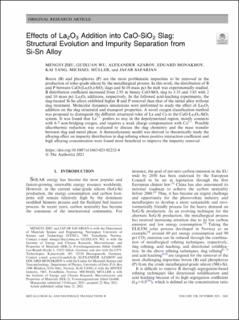Effects of La2O3 Addition into CaO-SiO2 Slag: Structural Evolution and Impurity Separation from Si-Sn Alloy
Zhu, Mengyi; Wu, Guixuan; Azarov, Alexander; Monakhov, Eduard; Tang, Kai; Müller, Michael; Safarian, Jafar
Peer reviewed, Journal article
Published version
Permanent lenke
https://hdl.handle.net/11250/2999320Utgivelsesdato
2021Metadata
Vis full innførselSamlinger
- Publikasjoner fra CRIStin - SINTEF AS [5649]
- SINTEF Industri [1534]
Originalversjon
Metallurgical and Materials Transactions B. 2021, 52 (5), 3045-3063. 10.1007/s11663-021-02232-4Sammendrag
Boron (B) and phosphorus (P) are the most problematic impurities to be removed in the production of solar-grade silicon by the metallurgical process. In this work, the distribution of B and P between CaO-(La2O3)-SiO2 slags and Si-10 mass pct Sn melt was experimentally studied. B distribution coefficient increased from 2.93 in binary CaO-SiO2 slag to 3.33 and 3.65 with 2 and 10 mass pct La2O3 additions, respectively. In the followed acid-leaching experiments, the slag-treated Si-Sn alloys exhibited higher B and P removal than that of the initial alloy without slag treatment. Molecular dynamics simulations were performed to study the effect of La2O3 addition on the slag structural and transport properties. A novel oxygen classification method was proposed to distinguish the different structural roles of La and Ca in the CaO-La2O3-SiO2 system. It was found that La3+ prefers to stay in the depolymerized region, mostly connects with 6-7 non-bridging oxygen, and requires a weak charge compensation with Ca2+. Possible silicothermic reduction was evaluated to discuss the slag chemistry and the mass transfer between slag and metal phase. A thermodynamic model was derived to theoretically study the alloying effect on impurity distribution in slag refining where positive interaction coefficient and high alloying concentration were found most beneficial to improve the impurity removal.

